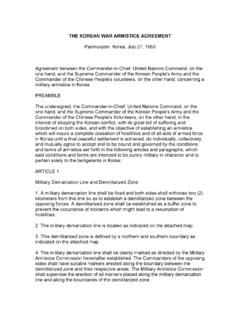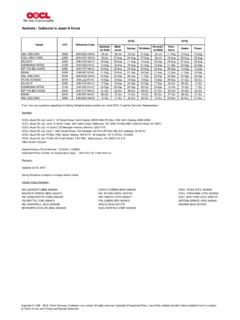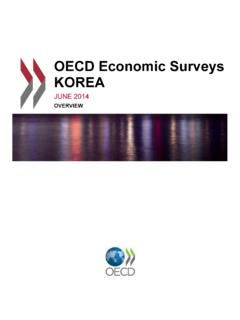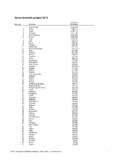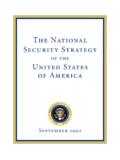Transcription of Future Directions in the DPRK’S Nuclear Weapons …
1 236 Massachusetts Avenue, NE, Suite 305 Washington, DC 20002 TEL FAX E-MAIL Future Directions in the dprk S Nuclear Weapons Program: Three Scenarios for 20201 By David Albright February 26, 2015 Like many secret Nuclear Weapons programs, the dprk goes to great lengths to hide its capabilities to produce Nuclear explosive materials and Nuclear Weapons . Despite these actions, a picture can be drawn of north korea s current and projected plutonium and Weapons -grade uranium (WGU) stocks. Knowing these plutonium and WGU stocks can, in turn, allow an estimate of the dprk s current number of Nuclear Weapons and a range of projections of the number north korea could build in the next several years. Although great uncertainty surrounds these projections, as well as the quality of north korea s Nuclear Weapons , these projections form a reasonable picture of the dprk s possible Nuclear Weapons futures, absent actions to significantly limit its Nuclear programs.
2 After summarizing estimates of stocks of separated plutonium and Weapons -grade uranium as of the end of 2014, this report develops three projections of Future Nuclear arsenals through 2020: low-end, medium, and high-end Nuclear futures. In developing these projections, which are intended to bound north korea s Nuclear futures, a number of constraints are considered, including the number and size of Nuclear production facilities, Future underground testing, the extent and success of Nuclear weaponization efforts, costs, and access to necessary goods and classified and proprietary technologies abroad. 1 Paper prepared for the north korea s Nuclear Futures Project at the US- korea Institute, Johns Hopkins School of Advanced International Studies, and originally published at The plutonium and weapon-grade uranium estimates through 2014 are part of a project that estimated plutonium and highly enriched uranium inventories worldwide that was generously supported by the Nuclear Threat Initiative.
3 ISIS REPORT 2 | P a g e Background The last several years have witnessed a dramatic and overt build-up in north korea s Nuclear Weapons capabilities. The main activities include: Separation of several kg of plutonium in 2009 after the collapse of the Six Party Talks; Conduct of underground Nuclear tests in 2009 and 2013; Restart of the small five megawatt-electric (MWe) reactor at Yongbyon after a several-year halt; Construction of an experimental light water reactor (ELWR) at Yongbyon; Revelation of a centrifuge plant at Yongbyon and subsequent doubling of its size; and Modernization and construction of many buildings at Yongbyon, probably to enable Future production of fuel for the 5 MWe reactor and the ELWR and to support the centrifuge plant. All these activities have increased suspicions that that there may be significant covert Nuclear activities, including the operation of a second centrifuge plant and the construction of Nuclear Weapons .
4 ISIS REPORT 3 | P a g e Current Plutonium and Weaponization Capabilities2 Separated Plutonium Stock As of the end of 2014, the dprk is estimated to have a stock of 30-34 kg of separated plutonium, or an average of 32 The plutonium was produced in a small Nuclear reactor at the Yongbyon Nuclear Scientific Research Center s 5 MWe reactor, which has a total thermal power of about 20 megawatt-thermal (MWth). Although the reactor is aged and started operating in 1986, north korea has been renovating it in recent years, implying that it may continue operating for many more. In the reactor, plutonium is produced in the uranium fuel along with other radioactive elements. The plutonium slowly builds up in the fuel and the entire core load of fuel is typically discharged every two to four years.
5 Because the discharged fuel is highly radioactive, it is transported in heavily shielded casks by truck to a nearby specialized processing plant, called the Radiochemical Laboratory. This plant chemically separates the plutonium from the uranium and other radioactive materials and converts it into metal form. As metal, the plutonium is the raw material for building Nuclear Weapons . Adjacent to the 5 MWe reactor, the dprk is constructing what is called an experimental light water reactor (ELWR) with a stated power of about 100 MWth and an electrical output of about 30-35 MWe. The ELWR has not yet started operation but could do so in 2015 or 2016. Whether the ELWR will be strictly for civil purposes is not known. In particular, will north korea use this reactor to make plutonium for Nuclear Weapons ? Normally, this type of reactor is not used to make Weapons -grade plutonium. However, north korea could deploy known methods to produce Weapons -grade plutonium in a practical manner and separate the plutonium in the Radiochemical Laboratory without major modifications.
6 If the ELWR were limited to strictly civilian use and optimized to make electricity economically, it would produce plutonium that is not ideal for Nuclear Weapons called reactor-grade plutonium. Typically, the fuel, in which the plutonium is produced, contains low-enriched uranium (LEU) containing about 3-4 percent uranium-235, and this fuel is typically heavily irradiated in this type of reactor, creating the reactor-grade plutonium rather than the more desirable Weapons -grade plutonium sought by Nuclear Weapons programs. Moreover, north korea s Radiochemical Laboratory is not designed to separate the plutonium from the ELWR fuel, and would require significant modifications to do so. If north korea wanted to use this reactor to produce Weapons -grade plutonium, it could do so using a more practical method developed in the 1980s by the US Department of Energy when it was considering alternative methods of making Weapons -grade plutonium and tritium for US Nuclear Weapons .
7 In this case, a light water reactor uses enriched uranium driver fuel (10-20 percent enriched in the isotope uranium-235) and natural or depleted uranium targets, where the Weapons -grade plutonium is produced in the targets. Reactor-grade plutonium would be 2 This section draws from Albright, north Korean Plutonium and Weapon-Grade Inventories, End 2014, January 15, 2015 (to be published). There is additional plutonium in the fuel in the core of the 5 MWe reactor and perhaps some in discharged irradiated fuel, but none of this plutonium is separated and thus unavailable for Weapons as of the end of 2014. However, this plutonium is added to the Nuclear explosive material stocks in the three post-2014 projections discussed below. This paper is part of a project that estimated inventories of plutonium and highly enriched uranium worldwide that was generously supported by the Nuclear Threat Initiative.
8 3 Ibid. ISIS REPORT 4 | P a g e produced in the driver fuel. The Weapons -grade plutonium in the targets would be recovered, and targets can be designed to make them relatively straightforward to process in the Radiochemical Laboratory, requiring manageable changes to this plant. An advantage of this method is that there would be no need to process the ELWR driver fuel; it can be stored indefinitely. The processing of this driver fuel would require major modifications to the Radiochemical Laboratory that would be hard to achieve in practice. However, with a driver/target system, the dprk could efficiently and on a sustained basis make Weapons -grade plutonium. Depending on design, it could produce up to 20 kg of Weapons -grade plutonium per year. Plutonium-Based Weapons north korea has stated publicly that is has built Nuclear Weapons .
9 Most of these Weapons are likely based on plutonium. Its effort to develop plutonium-based Nuclear Weapons goes back to at least the 1980s. This section estimates the number of Nuclear Weapons north korea could have built from its separated plutonium stock at the end of 2014. Little is known concretely about north korea s development or deployment of deliverable Nuclear Weapons , although it is likely able to build a warhead, perhaps one of limited reliability, which can fit atop a Nodong missile with a range of less than 800 north korea has worked on Nuclear weaponization for over 20 years and may have received Nuclear Weapons designs from the AQ Khan network in the 1990s or earlier from China, as Pakistan did in the early 1980s. These developments support assessments that north korea can build a miniaturized warhead for a Nodong and possibly other missiles. In particular, given the likely dimensions of such a warhead, Pyongyang should also be able to place it on a large Taepodong inter-continental ballistic missile (ICBM), although whether such a weapon would prove operationally effective remains unclear due to probable problems with reliability as well as what appears to be lack of reentry vehicle testing.
10 Any Nuclear Weapons program is likely to pursue successive designs that use smaller quantities of plutonium in each weapon. In the case of north korea , faced with a limited stock of plutonium, one would expect that the Nuclear weaponization program focused early on developing designs requiring less plutonium than that of first generation fission Weapons of the type detonated by the United States during the World War II Manhattan Project. The Trinity explosion contained about 6 kg of plutonium. Over time, north korea likely reduced the amount of plutonium it needed in each weapon to significantly less than 6 kg. In its Six Party declaration, the north stated that the 2006 Nuclear test contained only 2 kg of plutonium. Although there is wide skepticism about this particular declaration, it reinforces the point that north korea is likely seeking to use less plutonium in each test than the United States used in the Trinity test.
